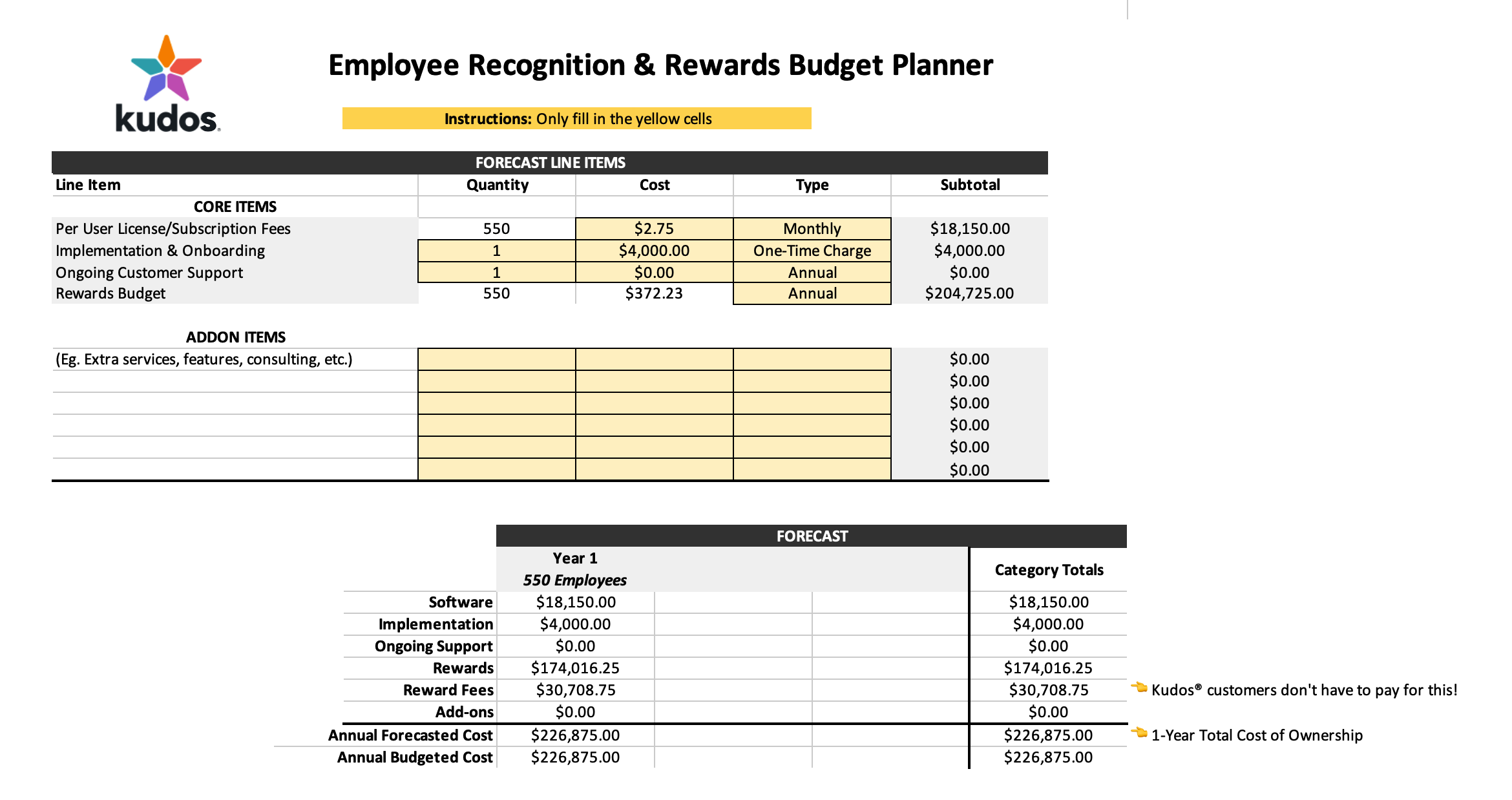Budgeting for Employee Recognition
ROI
September 10, 2025
Margaux Morgante
X min
ROI
September 10, 2025
Margaux Morgante
X min

Organizations are overwhelmingly finding that to retain great employees, they must strengthen their employee experience holistically through unique benefits, flexibility, and proactive employee engagement initiatives. One proven way to enhance employee engagement is through regular, meaningful recognition. The benefits of employee recognition programs are undeniable and plentiful.
When proposing employee recognition solutions, HR leaders are often tasked with building a budget for an enhanced program to get executive buy-in.
So how do you build a comprehensive budget for a new program from scratch?
How do you make sure you're comparing different solutions “apples to apples” to get a clear picture of which solution is best for your needs?
Before digging into the actual budgeting exercise, it’s important to level-set on why you’re considering bringing in an employee recognition platform so you can contextualize your budget with a legitimate need and urgency.
The Gallup Q12 Meta-Analysis is a fantastic resource to reference when building your case for the importance and impact of recognition. Here are some highlights:
Organizations with employee recognition programs are 12x more likely to have strong business outcomes.
With all of the value that employee recognition and engagement provides in mind, it’s now time to build your budget.
The following is designed to help you understand what key inputs and cost drivers make up that total cost so you can build an accurate and comprehensive budget.
Starting with benchmarks of how much today’s organizations invest in recognition and rewards provides your decision-makers with something to compare your proposal to. The benchmarks provided in this overview are for comprehensive recognition programs, like Kudos.
Beyond helping with your proposal, these benchmarks can help you assess how your current recognition budget compares to others and give you a place to start if this is a net new program and initiative. Keep in mind that many organizations migrate legacy “years-of-service” awards and annual recognition programs to their modern recognition system, so those costs are included in these benchmarks.
Current Benchmarks (per employee recognition budget benchmarks):
👉 Download Building Your Employee Recognition & Rewards Budget tip sheet to learn how to design a data‑driven recognition budget that boosts engagement, controls spend, and delivers measurable ROI.
.png)
👥 Employee count: Because you’re building your budget on a per-employee basis, this number is critical to an accurate proposal. Consider the exact size of your organization, whether it spans multiple regions, and whether there are various kinds of employees to consider (contract, field, temporary, interns). Larger organizations with multiple departments and regions might opt for a sequential implementation where, for example, a specific geography or division would start, then other groups would join in over a year or two. The timing of a staggered launch would have to be considered to make sure the budget is attributed at the right time.
🎁 Rewards or no rewards? Some vendors will give you the option of running your recognition program platform with or without monetary rewards and points. Some costs to consider are whether points need to be purchased in advance, if rewards are marked up, and the fulfillment costs of physical rewards. Hint: With Kudos, rewards are optional. Kudos also never marks up points and rewards. You are in complete control of your budget!
💰 Expected recognition and rewards budget per employee/year: Determine what you intend to spend on your program using the benchmarks above. You can also use the amount you’re spending on your current recognition/years of service program. For example, if you’ve recently moved to a remote work format, you could reallocate the budget from the expensive parties and receptions you’re no longer hosting.
↔️ Budget timeframe: Budgets are usually based on one fiscal year. Your CFO will likely want to know, beyond the fiscal year budget, what the total cost of ownership is for the program and the total cost of the agreement. For example, if you’ve committed to three years, fees for all three years would be included in your total cost of ownership. The total cost of ownership also consists of any additional resources required to run the program, such as staff time.
💸 Hidden fees: It’s essential to work directly with vendors to understand all fees and costs regarding rewards, markups, or fulfillment costs and any other resources you require. Your budget proposal should include a plan for who will manage this program (including one or two alternates).
🤝 Implementation & support: Ensure you understand the onboarding and launch process, including any information technology (IT) support needed. Your CFO needs to consider the opportunity cost of using IT resources for this project rather than another, so providing that information upfront is extremely helpful.
While all of this may seem overwhelming, the right vendor will be able to walk you through this process, making it painless and straightforward. To help, Kudos has a prebuilt Employee Recognition & Rewards Budget Planner.
The planner contains three helpful sheets:

Budgeting is a tedious but extremely valuable business process that allows you to make significant strides in your work.
Launching a formal recognition program is often a career-defining move for many HR professionals – it requires work and dedication, but the results are undeniable.
Finally, remember that this is the starting point. Depending on your organization's structure, policies, and needs, there can be nuances. This overview captures the baseline budgeting information needed for an employee engagement and recognition system.
If you need any assistance building your recognition program budget or learning more about the value of recognition and employee engagement systems, Kudos is here to help!
🎥 Want to see Kudos without the sales pitch? Watch our on-demand live demo to see how our recognition and rewards platform in action.
.png)

A newsletter with the best resources for HR professionals.


Employee recognition differs by industry. Knowing how to use it strategically can have an undeniable impact on your business’ success.
Get Your Guide